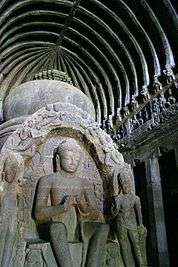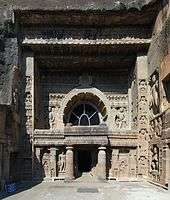Barabar Caves
.jpg) Barabar Caves, staircase and cave entrance | |
 Location in Bihar, India | |
| Alternate name | Barābār, Satgharva, Satgharwa |
|---|---|
| Location | Jehanabad district, Bihar, India |
| Coordinates | 25°00′18″N 85°03′47″E / 25.005°N 85.063°ECoordinates: 25°00′18″N 85°03′47″E / 25.005°N 85.063°E |
| Type | Caves |
| Part of | Barabar and Nagarjuni hills |
| History | |
| Founded | 322–185 BCE |
| Pilgrimage to |
| Buddha's Holy Sites |
|---|
 |
| The Four Main Sites |
| Four Additional Sites |
| Other Sites |
| Later Sites |
The Barabar Caves are the oldest surviving rock-cut caves in India,[1] mostly dating from the Maurya Empire (322–185 BCE), some with Ashokan inscriptions, located in the Makhdumpur region of Jehanabad district, Bihar, India, 24 km (15 mi) north of Gaya.
These caves are situated in the twin hills of Barabar (four caves) and Nagarjuni (three caves); caves of the 1.6 km (0.99 mi)-distant Nagarjuni Hill are sometimes singled out as the Nagarjuni Caves. These rock-cut chambers date back to the 3rd century BCE, Maurya period,[2] of Ashoka (reigned 273–232 BCE) and his grandson, Dasharatha Maurya. Though Buddhists themselves, they allowed various Jain sects to flourish under a policy of religious tolerance.[1]
The caves were used by ascetics from the Ajivika sect,[3] founded by Makkhali Gosala, a contemporary of Gautama Buddha, the founder of Buddhism, and of Mahavira, the last and 24th Tirthankara of Jainism.[4] Also present at the site are several rock-cut Buddhist and Hindu sculptures.[5]
Most caves at Barabar consist of two chambers, carved entirely out of granite, with a highly polished internal surface and exciting echo effect. The first chamber was meant for worshippers to congregate in a large rectangular hall, and the second, a small, circular, domed chamber for worship. This inner chamber probably had a small stupa-like structure, at some point, though they are now empty.
The caves were featured – located in a fictitious Marabar – in the book A Passage to India by English author E. M. Forster.[6] These were also shown in the book The Mahabharata Secret by Indian author Christopher C. Doyle.
Caves at Barabar Hill
Barabar Hill contains four caves: Karan Chaupar, Lomas Rishi, Sudama and Visva Zopri. Sudama and Lomas Rishi are the earliest examples of rock-cut architecture in India,[2][7] with architectural detailing made in the Mauryan period. Similar examples include the larger Buddhist Chaitya, found in Maharashtra, such as in Ajanta and Karla Caves. The Barabar caves greatly influenced the tradition of South Asian rock-cut architecture.[3] In addition, the Barabar caves have large arches which are few in ancient history.
|
|
|
- Lomas Rishi cave has an arch-like shape facade that imitates contemporary timber architecture. On the doorway, a row of elephants proceed towards stupa emblems, along the curved architrave.[8]
- Sudama cave was dedicated by Mauryan Emperor, Ashoka in 261 BCE. The arches of Sudama cave have bow shape. The caves consist of a circular vaulted chamber with a rectangular mandapa.[9]
- Karan Chaupar (Karna Chaupar) consists of single rectangular room with polished surfaces, contains inscription which could be dated to 245 BCE.
- Visva Zopri, reachable by Ashoka steps hewn in the cliff, consists of two rectangular rooms.[10]
Nagarjuni Caves
The nearby caves of Nagarjuna are smaller and younger than the Barabar caves.[11] The three caves are:
- Gopi (Gopi-ka-Kubha), devoted by the king Dasharatha to Ajivika followers circa 232 BCE, according to inscription.
- Vadithi-ka-Kubha cave (Vedathika Kubha) which are located in a crevice.
- Vapiya-ka-Kubha cave (Mirza Mandi) which is also devoted to Ajivika followers by Dasharatha.[12]
See also
Further reading
- Raymond, Allchin; Erdosy, George (1995). The Archaeology of Early Historic South Asia: The Emergence of Cities and States. Cambridge University Press. p. 247. ISBN 9780521376952.
References
- 1 2 Culture of peace Frontline, Volume 25 – Issue 18 :: 30 August – 12 September 2008.
- 1 2 "Sculptured doorway, Lomas Rishi cave, Barabar, Gya". www.bl.uk. Retrieved 11 May 2017.
- 1 2 "Entrance to one of the Barabar Hill caves". www.bl.uk. Retrieved 11 May 2017.
- ↑ Barabar Hills: Where the Buddhist Emperor Ashoka built caves for the Ajivakas www.buddhanet.net.
- ↑ "Rock sculptures at Barabar". www.bl.uk. Retrieved 11 May 2017.
- ↑ Bradshaw, David (12 April 2007). The Cambridge Companion to E. M. Forster. Cambridge University Press. pp. 188–. ISBN 978-0-521-83475-9.
- ↑ Architectural history www.indian-architecture.info. Archived 2008-09-14 at the Wayback Machine.
- ↑ "Part of the elephant frieze over the doorway at the Barabar caves. 1790". www.bl.uk. Retrieved 11 May 2017.
- ↑ "Sudama [and] Lomas Rishi Caves at Barabar [Hills], Gya". www.bl.uk. Retrieved 11 May 2017.
- ↑ "Rocky outcrop with Karna Chowpar cave, Barabar Hills.". www.bl.uk. Retrieved 11 May 2017.
- ↑ Barabar and Nagarjuna Caves
- ↑ "Gopi & Kalpi caves, Barabar, Gaya.". www.bl.uk. Retrieved 11 May 2017.
External links
| Wikimedia Commons has media related to Barabar Caves. |
- Detailed notes on the Barabar Caves and its use as Marabar Caves in E.M. Fosters Passage to India
- Barabar Caves and Nagarjuni Caves, description by Wondermondo
.jpg)





